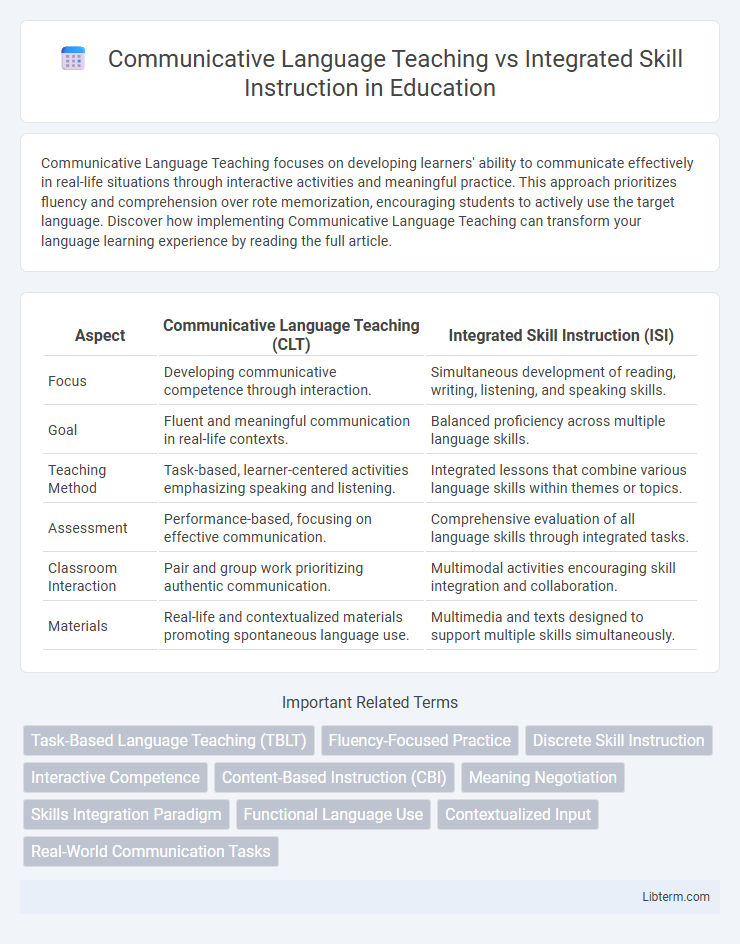Communicative Language Teaching focuses on developing learners' ability to communicate effectively in real-life situations through interactive activities and meaningful practice. This approach prioritizes fluency and comprehension over rote memorization, encouraging students to actively use the target language. Discover how implementing Communicative Language Teaching can transform your language learning experience by reading the full article.
Table of Comparison
| Aspect | Communicative Language Teaching (CLT) | Integrated Skill Instruction (ISI) |
|---|---|---|
| Focus | Developing communicative competence through interaction. | Simultaneous development of reading, writing, listening, and speaking skills. |
| Goal | Fluent and meaningful communication in real-life contexts. | Balanced proficiency across multiple language skills. |
| Teaching Method | Task-based, learner-centered activities emphasizing speaking and listening. | Integrated lessons that combine various language skills within themes or topics. |
| Assessment | Performance-based, focusing on effective communication. | Comprehensive evaluation of all language skills through integrated tasks. |
| Classroom Interaction | Pair and group work prioritizing authentic communication. | Multimodal activities encouraging skill integration and collaboration. |
| Materials | Real-life and contextualized materials promoting spontaneous language use. | Multimedia and texts designed to support multiple skills simultaneously. |
Introduction to Communicative Language Teaching
Communicative Language Teaching (CLT) emphasizes real-life communication and interaction as the core of language learning, encouraging learners to develop fluency and meaningful expression rather than just grammatical accuracy. This approach fosters authentic language use by integrating speaking, listening, reading, and writing skills within context-driven activities, promoting learner engagement and practical language proficiency. In contrast, Integrated Skill Instruction combines separate skill development with a more structured and balanced methodology, but CLT prioritizes communication as the fundamental goal of language education.
Key Principles of Integrated Skill Instruction
Integrated Skill Instruction emphasizes the simultaneous development of listening, speaking, reading, and writing to reflect real-world communication. Key principles include contextualized learning, where tasks mirror authentic language use, and the seamless integration of skills to enhance comprehension and fluency. This approach contrasts with Communicative Language Teaching, which often isolates speaking as the primary focus for interaction and meaning negotiation.
Historical Evolution of Language Teaching Approaches
Communicative Language Teaching (CLT) emerged in the 1970s as a response to the limitations of traditional grammar-focused methods, emphasizing real-life communication and interaction to develop language proficiency. Integrated Skill Instruction evolved earlier, promoting the simultaneous development of listening, speaking, reading, and writing skills to create a holistic language learning experience. Both approaches reflect shifts in linguistic theory and educational psychology, with CLT rooted in sociolinguistics and communicative competence, while Integrated Skill Instruction draws on cognitive and constructivist theories to foster balanced language skills.
Core Objectives: Communication vs Skill Integration
Communicative Language Teaching prioritizes developing learners' ability to use language effectively in real-life communication, emphasizing fluency, interaction, and authentic contexts to enhance speaking and listening skills. Integrated Skill Instruction focuses on combining multiple language abilities--reading, writing, listening, and speaking--into cohesive lessons to reinforce overall language proficiency through skill interdependence. The core objective of Communicative Language Teaching is functional communication competence, while Integrated Skill Instruction aims to create balanced linguistic growth by interlinking different language skills.
Classroom Practices in Communicative Language Teaching
Communicative Language Teaching (CLT) emphasizes meaningful interaction and real-life communication scenarios, encouraging students to actively use language through role-plays, group discussions, and problem-solving tasks. Classroom practices in CLT prioritize learner-centered activities that foster authentic language use, fluency, and collaborative learning, rather than rote memorization or isolated grammar drills. Teachers act as facilitators, providing feedback and promoting communication strategies that enhance oral proficiency and pragmatic competence in diverse contexts.
Techniques and Activities for Integrated Skill Instruction
Integrated Skill Instruction employs techniques like task-based learning, where learners engage in real-life tasks that combine listening, speaking, reading, and writing to enhance practical language use. Activities often include role-plays, collaborative projects, and multimedia presentations that facilitate simultaneous skill development and contextual comprehension. This approach contrasts with Communicative Language Teaching by emphasizing the concurrent integration of multiple language skills rather than focusing predominantly on oral communication.
Strengths and Limitations of Each Approach
Communicative Language Teaching (CLT) excels in promoting real-life communication skills and fluency through interactive activities, but it may neglect explicit grammar instruction and accuracy. Integrated Skill Instruction combines listening, speaking, reading, and writing to create a balanced language learning experience, yet its broad focus can sometimes limit depth in any single skill area. Both approaches require careful adaptation to learner needs and contextual factors to maximize effectiveness in language acquisition.
Learner Outcomes and Assessment Strategies
Communicative Language Teaching (CLT) emphasizes learner outcomes such as communicative competence, fluency, and the ability to use language pragmatically in real-life contexts, assessed through performance-based tasks like role-plays and oral interviews. Integrated Skill Instruction prioritizes simultaneous development of reading, writing, listening, and speaking skills, with learner outcomes measured via holistic assessments, including portfolios and integrated language tests. Both approaches deploy formative assessments but differ in focus: CLT targets interaction effectiveness, while Integrated Skill Instruction evaluates balanced proficiency across multiple language domains.
Adapting Methods for Diverse Learning Contexts
Communicative Language Teaching emphasizes interaction and real-life communication, adapting well to diverse cultural and linguistic backgrounds by prioritizing speaking and listening skills. Integrated Skill Instruction combines reading, writing, speaking, and listening, offering a holistic approach that can be tailored to support learners with varying proficiencies and learning preferences. Effective adaptation in diverse learning contexts requires blending both methods to address specific educational goals and learner needs, ensuring language acquisition is both practical and comprehensive.
Future Trends in Language Teaching Methodologies
Future trends in language teaching methodologies emphasize the fusion of Communicative Language Teaching (CLT) and Integrated Skill Instruction to create holistic learning experiences. Emerging technologies and digital platforms facilitate real-time interaction, enabling personalized and context-rich communication practice across reading, writing, listening, and speaking skills. Adaptive learning systems and AI-driven analytics are poised to refine skill integration, enhancing learner engagement and proficiency in dynamic, authentic language contexts.
Communicative Language Teaching Infographic

 libterm.com
libterm.com